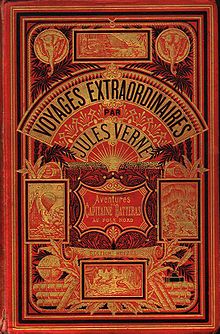 A typical in-8º Hetzel cover for the Voyages Extraordinaires. The novel is Les Aventures du Capitaine Hatteras au Pôle Nord, and the cover style is "Aux deux éléphants" ("With two elephants"). | |
| Author | Jules Verne |
|---|---|
| Country | France |
| Language | French |
| Publisher | Pierre-Jules Hetzel |
| Published | 1863–1905 (additional novels revised or written by Michel Verne added 1905–1919) |
| Media type | print (hardcover and paperback) |
The Voyages extraordinaires (French: [vwajaʒ ɛkstʁaɔʁdinɛʁ]; lit. 'Extraordinary Voyages' or 'Amazing Journeys') is a collection or sequence of novels and short stories by the French writer Jules Verne.
Fifty-four of these novels were originally published between 1863 and 1905, during the author's lifetime, and eight additional novels were published posthumously. The posthumous novels were published under Jules Verne's name, but had been extensively altered or, in one case, completely written by his son Michel Verne.[1][2]
According to Verne's editor Pierre-Jules Hetzel, the goal of the Voyages was "to outline all the geographical, geological, physical, historical and astronomical knowledge amassed by modern science and to recount, in an entertaining and picturesque format ... the history of the universe."[3]
Verne's meticulous attention to detail and scientific trivia, coupled with his sense of wonder and exploration, form the backbone of the Voyages. Part of the reason for the broad appeal of his work was the sense that the reader could gain real knowledge of geology, biology, astronomy, paleontology, oceanography, history and the exotic locations and cultures of the world through the adventures of Verne's protagonists. This great wealth of information distinguished his works as "encyclopedic novels".
The first of Verne's novels to carry the title Voyages Extraordinaires was The Adventures of Captain Hatteras, which was the third of all his novels.
The works in this series are adventure stories, some with overt science fiction elements (e.g., Journey to the Center of the Earth) or elements of scientific romance (e.g., Twenty Thousand Leagues Under the Seas).
- ^ Nash, Andrew. "Jules Verne - Extraordinary Journeys". The Jules Verne Collecting Resource Page. Retrieved 29 March 2022.
- ^ Dehs, Volker; Jean-Michel Margot; Zvi Har'El. "The Complete Jules Verne Bibliography: I. Voyages Extraordinaires". Jules Verne Collection. Zvi Har’El. Retrieved 6 September 2012.
- ^ Pérez, Ariel; de Vries, Garmt; Margot, Jean-Michel (2008). "Jules Verne FAQ". Jules Verne Collection. Zvi Har’El. Retrieved 26 March 2013.